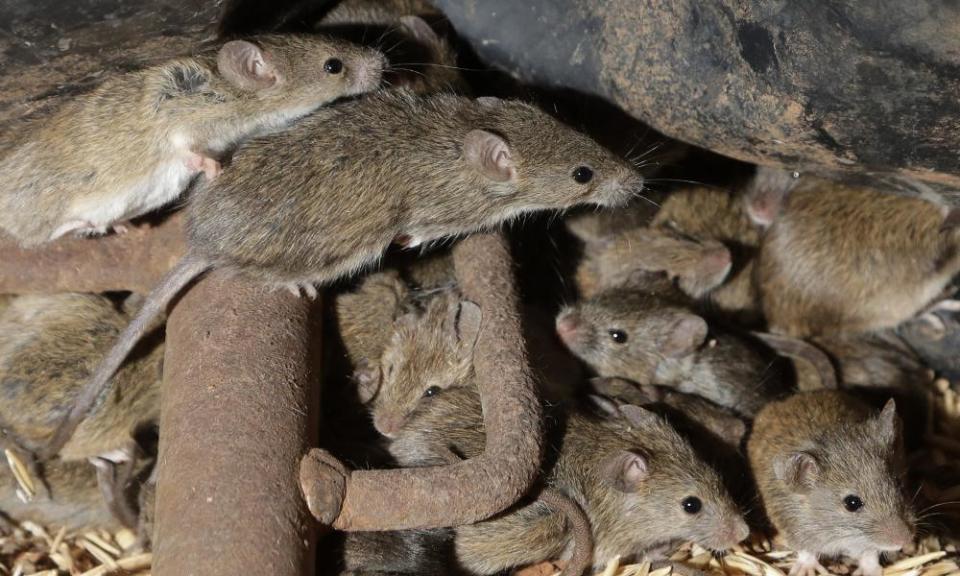NSW plan to use ‘napalm’ poison to control mouse plague rejected over fears for wildlife

The national pesticides regulator has refused a request from the New South Wales government to allow farmers to use a rodent poison described as “napalm for mice” around crops to battle the devastating mouse plague.
Conservationists had warned the use of bromadiolone would have devastating affects on native species in the central west and put endangered birds at risk.
The blood-thinning chemical– part of a class of poisons called second generation anticoagulant rodenticides (SGARs) – is known to stay active for months and can pass through the food chain, causing secondary poisoning of animals that eat the dead and dying.
The Australian Pesticides and Veterinary Medicines Authority wrote to the NSW Department of Primary Industries on Wednesday to say its two emergency permit applications to use the poison, submitted in May, would be declined.
APVMA chief executive Lisa Croft said: “The APVMA’s primary concern is environmental safety, particularly in relation to animals that eat mice.
Related: Powerful owl deaths fuel concerns mouse poison is spreading through food chain
“Before the APVMA is able to approve any application, we must be certain that it is safe, that it will work, and that it will not prevent our farmers from selling their produce overseas.”
The authority has approved six other emergency permit applications to use zinc phosphide, which can still harm wildlife but does not have the same long-lasting affects.
Watch: After fire and floods, Aussie farmers suffer devastating mouse plague
Bromadiolone is only approved for use in and around buildings and, like other SGARs, is widely available to the public.
But there is emerging evidence in Australia that their widespread use is having negative affects on native wildlife, including owl and threatened eagle populations.
Scientists and conservationists had feared a broad release of bromadiolone to control the mouse plague could have devastated populations of the threatened superb parrot.
The APVMA has given the state 28 days to respond, but the NSW agriculture minister, Adam Marshall, said he accepted the decision.
“The APVMA was extremely diligent in its consideration of our request and despite being disappointed [at] not getting the outcome we wanted for the state’s farmers, they are the independent regulator and we accept the umpire’s decision.”
The NSW government had secured a supply of 10,000 litres of bromadiolone and Marshall said in May it would be “the equivalent of napalming mice across rural NSW.”
He said on Wednesday: “Resources that were to be used to distribute bromadiolone will now be redeployed to support the other key support measures.”
In a statement, NSW Farmers Association vice president Xavier Martin said the association supported the APVMA’s decision and said his members had concerns about the risks of using the poison.
The boom in the non-native mice has devastated crops and grain, and caused damage to homes, buildings and machinery. There have been reports of a stench of mouse urine, of dead mice and of the rodents flooding homes and biting children and crawling over people in their sleep.
Related: Australia’s mouse plague: six months ago it was war, now whole towns have accepted their presence
Martin said a cold snap had “slowed activity down, particularly in the central west region” and while farmers were reporting a fall in mice numbers in the north-west region and Riverina, “many are still baiting and are concerned about a return to plague proportions in spring”.
BirdLife Australia is campaigning to stop SGRs being sold to the general public and had asked the APVMA to block the permits.
Holly Parsons of BirdLife Australia welcomed the decision, adding: “We still have concerns about the impacts that second-generation anticoagulant rodenticides have on our wildlife but are glad that such a mass quantity has been stopped from entering our agricultural and natural food chains.”
The NSW Environment Protection Authority has said previously that some bird deaths reported in the central west region had been caused by zinc phosphide, but there were no reports of poisons being misused.
Parsons added: “We note the six additional permits to distribute zinc phosphide, and call again on the APVMA to implement additional monitoring of potential impacts to wildlife from this chemical.”
Marshall said the government had allocated $150m to give farmers a 50% discount on zinc phosphide purchases.
Regional households can also claim rebates of up to $500 for mouse bait, traps and cleaning products and small businesses can claim up to $1,000.
Watch: Researchers grew mice embryos in artificial wombs

 Yahoo Movies
Yahoo Movies 